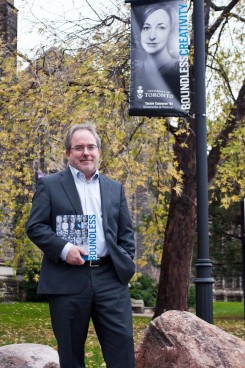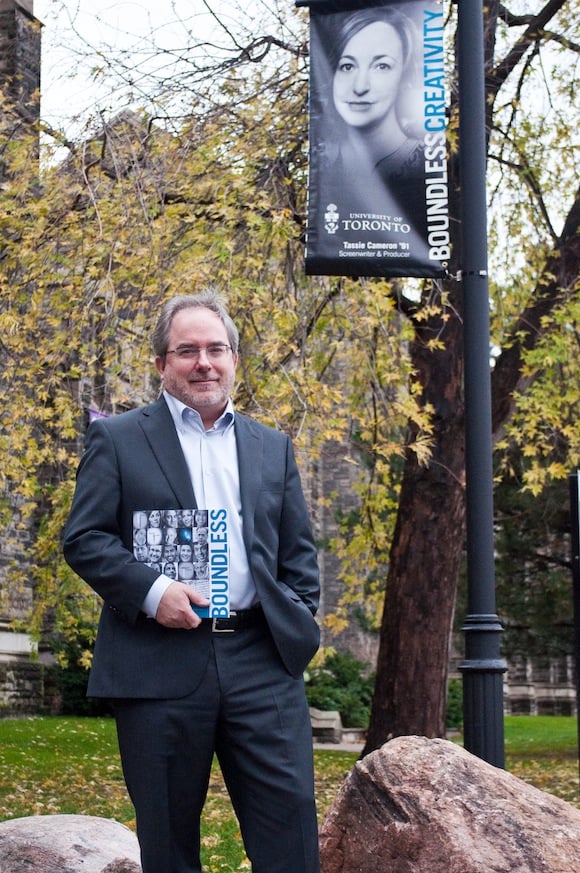The University of Toronto formally launched “Boundless,” a historic $2 billion fundraising program, last week in Convocation Hall.
As the university’s “third organized campaign in the last 30 years,” according to Vice-President of Advancement David Palmer, Boundless aims to raise at least $600 million to globalize U of T’s student body and $1.4 billion to “meet global challenges.” A significant portion — $966 million — has already been pledged to the university during the last five years in the program’s “silent” phase.
Academic divisions have submitted $3.2 billion worth of funding requests for student programming, financial aid, faculty, and capital projects, says Palmer.
“We certainly hope that the $2 billion will be the minimum that we achieve,” he adds, pointing out that philanthropy only funds 30 to 50 per cent of such projects and the rest comes from other university sources and government grants.

Vice-President of Advancement David Palmer poses with the Boundless handbook in front of Simcoe Hall. SARAH TAGUIAM/THE VARSITY
Alumnus Paul Cadario, who has funded fellowships and scholarships in the School of Public Policy and Government, plans to support the university’s Boundless initiative.
“I could not be happier with how my gifts have had an impact,” he says. “I think I’m typical of many donors in that you support charities … because you know about them, and you like what they do, and you like how they do it.”
Cadario, an engineering graduate and a Senior Manager at the World Bank, says that he’s “especially excited” about the Centre for Global Engineering.
Despite the optimism of donors like Cadario, students groups have raised concerns on philanthropy’s possible impact on the university’s autonomy and academic integrity.
The GSU and UTSU, are wary that donors might use their funding as an opportunity to push a specific agenda.
“Corporations have considerable influence at the institution, as we have seen at the Governing Council, where our government appointees often come from the private sector,” says UTSU President Danielle Sandhu.“We have seen a considerable resistance from students, staff and faculty over concerns of donor influence, particularly in relation to Peter Munk and the Munk School of Global Affairs.”
Palmer points out that donor agreements contain “a number of clauses that explicitly protect university’s freedom” and that the “first clause in every donor agreement is the protection of [the university’s] academic rights and freedom.”
U of T president David Naylor understands the student groups’ concerns but feels they can become overblown.
“I think it’s reasonable for people to always keep an eye on anything that might compromise our intellectual independence or academic freedom,” he says. “But I also think at times, this becomes something of a line of easy sloganeering, rather than a genuine sustainable concern.”
Sandhu is also concerned that the campaign will lessen the provincial government obligation to increase student funding.
“By undertaking this campaign to make up for the chronic underfunding of education by the provincial government, we fear there is a disincentive created for the government to inject public dollars into the university,” she says. “Our members are studying in the province with the highest tuition fees, lowest per-student funding, and largest class sizes.”
Palmer admits that government funding in Ontario universities has been “tightly constrained.”
“Government funding of universities in Ontatio, in real dollars, has been on a fairly steady decline,” he says. Palmer, however, pointed out that despite the tough economic times, the university has received some of its “largest gifts” in the past two or three years.
“We are intending to be ‘boundless’ in our pursuit of improved funding for the core operations of the university, understanding that it’s a tough time when this may not be exactly the moment to press aggressively,” says Naylor. “But as soon as things turn a little bit for the government, I think it’s essential for them to try to narrow the gap in per-student funding between Ontario and some of the other provinces.”


